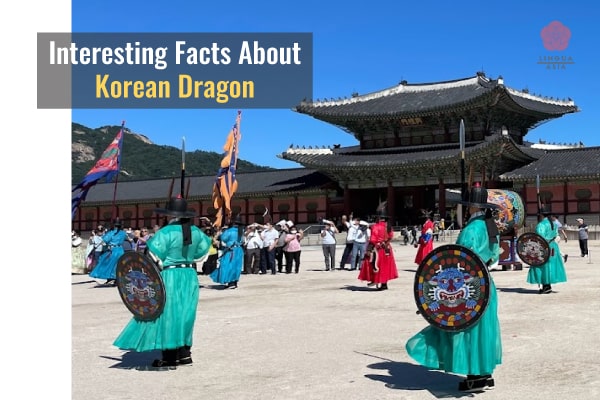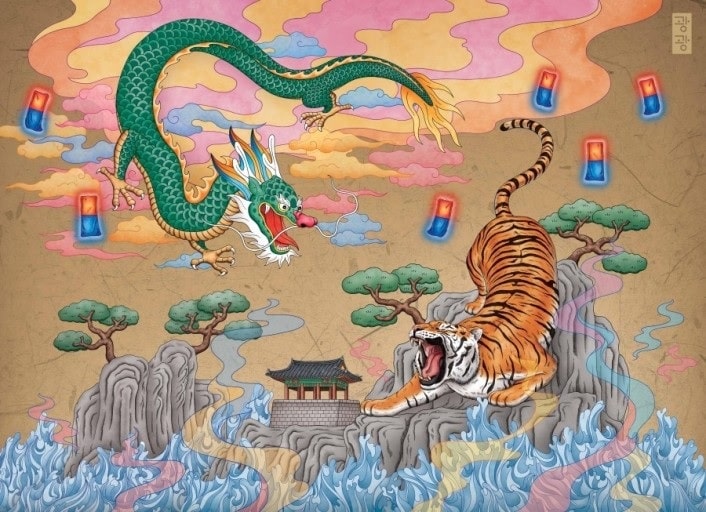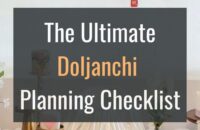Korean dragons are large magical legendary creatures that are often benevolent figures in mythology.
Since I was born in the year of dragon, I felt like I had to write about this.
Here are some interesting facts about Korean dragons!

Quick Summary
- Dragons are called yong in Korean.
- In Korean mythology, a snake (Imoogi) becomes a dragon and rises to the sky after a 1,000-year spiritual training session and obtaining a Yeouiju (orb).
- Korean dragons are benevolent, and control water.
※Nerd Alert!※
There will be numerous references to some geeky stuff that polite company might want to avoid. I recommend watching all 9 seasons of Dragonball Z and Game of Thrones season 1-6 for context.
What are Korean dragons called?
Korean dragons are called “Yong (용)” and sometimes a pure Korean word, “Miru (미르)“, is used.
You might’ve heard “Imoogi (이무기)“, but it means a large serpent with special powers that failed to or hasn’t yet become a dragon. (**I’ll give you the full story about Imoogi later in this post!)
Also, dragons are legendary creatures and one of the four benevolent animals: the Dragon, Phoenix, Turtle and Qilin (a type of mythical chimera in East Asia).
Korean dragons were created by adding Buddhist elements and a drop of Korean creativity on top of the Chinese (Asian) dragon format.
What do Korean dragons symbolize?

It’s also called the Dragon Throne (Yongsang)
Korean dragons symbolize a few things that are all positive.
Yong is a symbol of:
- great hope and achievement! Gateway to success is “deung-yong-mun (등용문)” in Korean. When someone from a humble family becomes successful, we say, “a dragon rises from the creek (개천에서 용 난다)“.
- fortune, lucky omen and blessing! Koreans love “dreaming of a dragon” at night, which is considered the best and luckiest dream. Some even draw a picture of their dragon dream (용꿈) to keep the blessings coming.
- kingship or throne! Kind of like House of the Dragon, but without actual or CG dragons. The King’s face was called Yongan (용안) as in “dragon’s face”. The King’s garment was Yongpo (용포) as in “dragon’s robe”. The throne was Yongsang (용상) as in “dragon’s bench”. Even a King’s tear was called Yongru (용루), a “dragon’s tear”.
What is a Yeouiju?

Photo courtesy of Earth Traveler blog
Yeouiju is pretty much the same dragon ball that you think of from the anime. A mystical orb that grants your wishes.
In Korean mythology, a snake (Imoogi) goes through a 1,000-year spiritual training session. It then obtains a Yeouiju to become a dragon and rise to the sky.
But there’s a catch. It must hold only one Yeouiju. A greedy Imoogi will collect more orbs and can never be a dragon. It just ends up being a stronger Imoogi. I think there’s a lesson about greed here.
The supernatural power of Yeouiju is the reason why Korean dragons can fly in the sky, call the winds and summon the rains. Pretty neat stuff.
When a dragon loses its Yeouiju, it will lose its power, fall to the ground and become an Imoogi again.
So, Korean dragons are often depicted holding that orb tight in its mouth, or sometimes under its chin or even inside its brain.
Are Korean dragons considered gods?
Korean dragons are divine creatures and there was once a folk religion that worshiped the Dragon God (용신신앙).
It happened naturally because Koreans believed that dragons were water gods and water was a crucial part of agricultural life.
Koreans held rainmaking rituals that honored the dragon of their region (Korean dragons have their own territory), or de facto rain god.
Koreans also assume that the Dragon King (Yongwang) lives in a Dragon Palace (Yonggung) under water. Just picture the Korean version of Aquaman!

What are idioms/expressions related to Korean dragons?

- 개천에서 용 난다 (gae-chun-eh-suh yong nan-da): A dragon rises from the creek. It means a person from a humble family becomes successful, like a dragon rising from a small stream, not a big river.
- 등용문 (deung-yong-mun): Going up to the dragon gate. It means a gateway to success.
- 용두사미 (yong-doo-sa-mi): Dragon’s head and snake’s tail. It means anticlimax.
- 용호상박 (yong-ho-sang-bak): Dragon and tiger fighting each other. It means an evenly-matched contest.
- 화룡점정 (hwa-ryong-jeom-jeong): Marking the pupil after drawing the entire dragon. It means the finishing stroke or final touch is the most important.
What are the differences between Western and Asian dragons?

There are clear differences between Western dragons and Asian/Korean ones as shown above. They’re actually complete opposites in many ways.
| Western Dragon | Asian Dragon | |
| Name in Korean | Deu-rae-gon (드래곤) | Yong (용) |
| Appearance | A gigantic, bat-winged, scaly lizard | A slim serpent with eagle claws, deer horns, lion’s mane, pig’s snout and an old man mustache |
| Power | Fire-breathing | Water-controlling |
| Perception | Evil | Benevolent |
| Worshipped | X | O |
| Yeouiju (Magic Orb/Pearl) | X | O |
Where can you see Korean dragons?

Sadly, you can’t see any real Korean dragons… But, you can visit some dragon-related attractions in Korea!
- Yongheungsa Temple in Damyang, the temple where dragons were born
- Haedong Yonggungsa Temple in Busan, the temple version of Korean Dragon Palace
- Yongmeori Coast on Jeju, a cool rocky coastline that resembles a dragon’s head jumping into the ocean
- Yongduam Rock on Jeju, a volcanic stone statue made by nature that looks like a dragon’s head
Or, you can visit any traditional Korean building like palaces or temples to play hidden object games and find dragon shapes.
Hint: Check the tips of roofs, statues on the ground, and artifacts!

When is the Year of the Dragon?
If you were born in 2012, 2000, 1988, 1976, 1964, 1952, 1940, 1928, 1916 or 1904, congratulations! You’re part of the Dragon family!
Also, babies born in 2024 will be dragons as well.
Korean celebrities tend to make an inner circle (or social club) with same Korean zodiac sign, like Yong-tti (용띠) club, etc.
Famous yong-tti celebrities born in ’88 are: G-Dragon, Taeyang, Taecyeon, Nichkhun, Yim Si-wan, Park Seo-joon, Lee Yeon-hee, Uee, Yubin, and Jessi
Subscribe for
exclusive info on Korea
Did we miss anything?
Let us know your thoughts or questions about Korean dragons!



